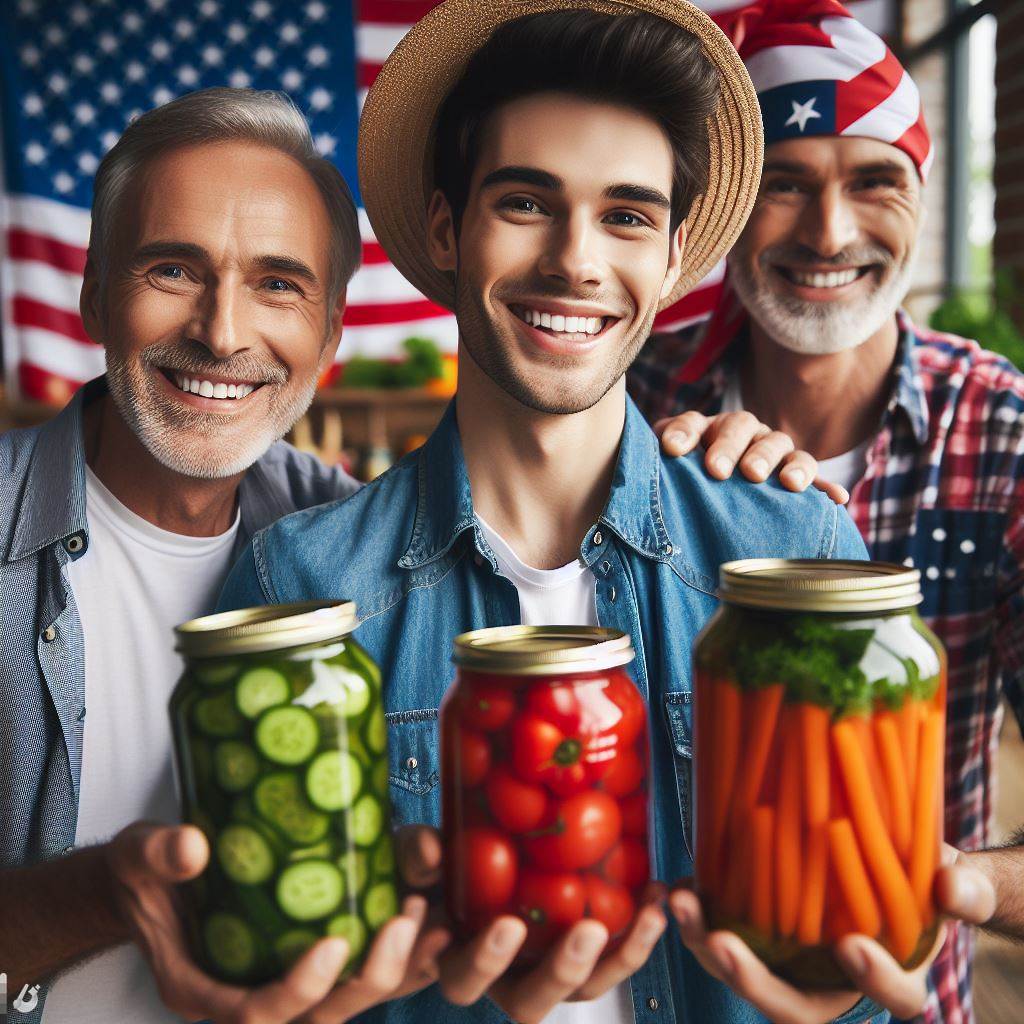Importance
Preserving the harvest is important to prevent food waste and enjoy fresh produce year-round.
Canning is a popular method of preserving fruits, vegetables, and other food items.
This blog post aims to provide a comprehensive guide to canning for beginners.
Overview of canning
Canning allows you to enjoy the flavors of summer throughout the year.
By canning, you can save money and have control over the ingredients in your food.
This blog post will cover the basics of canning, including equipment needed and step-by-step instructions.
Canning is a simple process that requires a few key supplies.
Mason jars, lids, and a water bath or pressure canner are essential for successful canning.
Purpose of the blog post
In this blog post, we will discuss the importance of using high-quality, sterilized jars and how to properly seal them.
The blog post will also provide a step-by-step guide to canning your harvest.
We will cover preparing the produce, boiling the jars, and filling them with the preserved goods.
Additionally, we will discuss the correct processing time for different foods and methods of storage.
Safety is crucial when canning, and we will address common concerns and precautions.
Properly processed and sealed jars should be stored in a cool, dark place to maintain quality.
Finally, we will provide tips for troubleshooting common canning issues and resources for further information.
Transform Your Agribusiness
Unlock your farm's potential with expert advice tailored to your needs. Get actionable steps that drive real results.
Get StartedPreserving the harvest through canning is a rewarding and sustainable practice.
By following the steps outlined in this blog post, you can confidently preserve your own delicious, homemade goods.
Get ready to embark on a journey of preserving flavors and creating lasting memories with canning!
Benefits of Canning
Extending the shelf life of fresh produce
- Canning allows you to enjoy seasonal fruits and vegetables throughout the year.
- By preserving fresh produce, you can avoid spoilage and wastage.
- With canning, you can stock up on your favorite fruits and vegetables when they are in abundance.
- Preserving foods through canning ensures that you have a ready-to-eat and nutritious option at your disposal.
- You can savor the flavors of summer even during the colder months by canning fruits like peaches and strawberries.
Reducing food waste
- One of the major benefits of canning is the reduction of food waste.
- By canning excess produce, you can avoid throwing away fruits and vegetables that may otherwise go bad.
- Food waste contributes to environmental issues, and canning helps you play your part in reducing it.
- Instead of letting your excess produce rot in the fridge, canning allows you to make good use of it.
- Canning helps in minimizing the impact of food waste on landfills.
Ensuring the availability of nutritious food
- When you can fresh produce, you seal in its natural nutrients, ensuring their availability throughout the year.
- Preserving fruits and vegetables through canning helps retain essential vitamins, minerals, and antioxidants.
- Having a pantry stocked with canned food ensures that you always have access to nutritious ingredients.
- You can enjoy the benefits of a well-balanced diet even during off-seasons.
- Canning is a great way to make sure you have a supply of healthy food during emergencies or natural disasters.
In essence, canning offers various benefits such as extending the shelf life of fresh produce, reducing food waste, and ensuring the availability of nutritious food.
By taking up canning, you can enjoy your favorite fruits and vegetables all year round, minimize food waste, and have a nutritious option readily available.
Remember, canning is not only a practical way to preserve food but also a sustainable choice that positively impacts both your health and the environment.
So, start preserving the harvest today and reap the benefits of canning!
Read: Herbs and Spices: Grow Your Own
Supplies Needed for Canning
When it comes to canning, having the right supplies is essential for a successful and safe preservation process.
Here is a detailed list of the supplies you will need:
Canning jars
Select jars specifically made for canning, ensuring they are in good condition without any cracks or chips.
Choose the appropriate size depending on the quantity of food you plan to preserve.
Lids and bands
Use new, unused lids for each canning session.
Bands can be reused as long as they are not bent or rusted.
Canning pot or pressure cooker
A canning pot is ideal for high acid foods, while a pressure cooker is necessary for low acid foods to prevent the growth of harmful bacteria.
Make sure the pot or cooker is large enough to hold all the jars and has a rack to elevate them from direct contact with the pot’s bottom.
Jar lifter
A jar lifter allows you to safely lift hot jars in and out of boiling water.
Look for one with a sturdy grip and heat-resistant handles.
Funnel
A wide-mouth funnel helps in filling jars with hot liquids or chunky fruits and vegetables.
Look for a funnel that can fit the mouth of your jars, preferably made of heat-resistant material.
Kitchen towels
Have plenty of clean kitchen towels on hand for wiping down jars, drying hands, and providing a clean and safe working surface.
Remember to always follow the manufacturer’s guidelines for each of these supplies and ensure they are in good condition before use.
By having all the necessary supplies, you can confidently embark on the canning journey and preserve the harvest to enjoy throughout the year.
Read: CSA Boxes: Your Weekly Surprise
Showcase Your Farming Business
Publish your professional farming services profile on our blog for a one-time fee of $200 and reach a dedicated audience of farmers and agribusiness owners.
Publish Your ProfileSteps to Prepare for Canning
Selecting fresh and ripe produce
- Choose fruits and vegetables that are at the peak of their freshness and ripeness.
- Avoid using bruised or damaged produce as it may affect the quality of the final product.
- Consider buying from local farmers’ markets or growing your own fruits and vegetables.
Washing and sanitizing jars and lids
- Thoroughly clean the jars and lids with hot, soapy water to remove any dirt or debris.
- Rinse the jars and lids with hot water and then submerge them in a pot of boiling water for sterilization.
- Alternatively, place the clean jars and lids in a dishwasher and run a sanitizing cycle.
Preparing the canning area
- Choose a well-ventilated area with enough space to work comfortably.
- Clean and disinfect all surfaces, including countertops and cutting boards, to maintain food safety.
- Gather all the necessary tools and equipment, such as a canner, canning funnel, and hot pads.
Getting all the necessary ingredients
- Check your canning recipe to determine the specific ingredients needed for the desired recipe.
- Make a list and ensure you have enough fresh produce, vinegar, sugar, and spices on hand.
- Consider having extra ingredients in case you need to make adjustments during the canning process.
Having a canning recipe in hand
- Find a trusted canning recipe that matches the produce you are using and the method you want to employ.
- Ensure the recipe is from a reliable source, such as a reputable cookbook or a trusted canning website.
- Read the recipe thoroughly and familiarize yourself with the steps and required processing times.
By following these steps to prepare for canning, you will be ready to embark on a successful canning journey.
Remember that proper preparation is essential for achieving safe and delicious canned goods.
Read: Winter’s Harvest: Cooking Seasonal Produce
Water Bath Canning Method
Preparing the produce
- Wash the fruits or vegetables thoroughly.
- Peel, pit, and core the necessary produce according to the recipe.
- Cut them into the desired size and shape, ensuring uniformity.
- Place the prepared produce in a clean bowl, ready for canning.
Filling the jars with the prepared produce
- Inspect the jars for any cracks, chips, or defects before use.
- Fill the jars using a funnel, leaving the recommended headspace for expansion.
- Use a non-metallic utensil to gently remove air bubbles from the filled jars.
Adding the hot liquid or syrup to the jars
- Prepare a hot liquid or syrup based on the recipe’s instructions.
- Carefully pour the hot liquid or syrup into the jars over the prepared produce.
- Ensure the liquid covers the produce while maintaining the recommended headspace.
Removing air bubbles and ensuring proper headspace
- Slide a non-metallic utensil between the food and the jar’s inner walls to release trapped air.
- Adjust the headspace if necessary by adding more hot liquid or removing excess fluid.
Applying lids and bands
- Wipe the jar rims with a clean, damp cloth to remove any food particles.
- Place the lids on the jars’ rims, ensuring they fit snugly.
- Screw the bands on firmly but not overly tight to allow air escape during processing.
Processing the jars in a boiling water bath
- Place a rack or towel at the bottom of a large pot to prevent jar breakage.
- Arrange the filled jars on the rack, ensuring they do not touch each other.
- Fill the pot with enough hot water to cover the jars by at least 1 inch.
- Cover the pot and bring the water to a rolling boil.
- Start the processing time as stated in the recipe, adjusting for altitude if necessary.
Cooling and storing the canned goods
- Once the processing time is complete, turn off the heat and carefully remove the pot lid.
- Lift the jars out of the water using jar lifters and place them on a heat-resistant surface.
- Allow the jars to cool undisturbed for 12 to 24 hours to ensure proper sealing.
- Check the seals by pressing the center of the lids. If they don’t flex, the jars are sealed.
- Label the jars with the contents and date before storing them in a cool, dark place.
- Use your preserved produce within a year to enjoy the best quality and flavor.
Read: Farmers’ Markets: A Shopper’s Guide

Pressure Canning Method
Overview of pressure canning
Pressure canning is a method of preserving food that uses high-pressure steam to safely store perishable items.
Preparing the produce
Wash, peel, and cut the produce into appropriate sizes, ensuring quality and removing any spoiled parts.
Filling the jars with the prepared produce
Carefully pack the cleaned jars with the prepared fruits, vegetables, or meats.
Do not overfill the jars to avoid spoilage.
Adding liquid to the jars
Pour a suitable liquid like water, broth, or sauce into the jars, leaving a specific headspace for heat expansion.
Applying lids and bands
Place the lids on the filled jars and tighten them with the bands until they are secure but not overly tight.
Processing the jars in a pressure canner
Set up the pressure canner according to the manufacturer’s instructions and process the jars for the recommended time and pressure.
Cooling and storing the canned goods
After processing, allow the pressure canner to cool naturally.
Once cooled, remove the jars and check for proper seals.
Label, date, and store the jars in a cool, dark place.
The pressure canning method is an effective way to preserve a wide range of foods, providing long shelf-life and retaining nutritional value.
By following the proper steps, you can safely store your harvest to enjoy year-round.
Explore Further: Summertime’s Fresh Picks: Local Produce
Explore Further: Fresh Summer Fruits: From Farm to Your Table
Tips for Successful Canning
Following tested and reliable recipes
- Stick to recipes from trusted sources that have been tested for safety and reliability.
- Avoid altering ingredients or proportions in canning recipes to maintain proper acidity levels.
- Use up-to-date recipes that comply with current safe canning practices.
Using proper canning techniques
- Ensure all equipment is in good condition, clean, and suitable for canning purposes.
- Follow USDA guidelines for filling jars with the correct amount of headspace to allow for proper sealing.
- Use appropriate canning methods for the type of food being preserved, such as water bath canning or pressure canning.
- Pay attention to the correct processing time and temperature specified in the recipe.
- Avoid double-stacking jars in a canner to ensure proper heat distribution and thorough processing.
Adjusting processing times for different altitudes
- Check your altitude using an altimeter or consult local resources to determine the correct adjustment needed.
- Increase processing time when canning at higher altitudes to compensate for lower boiling points.
- Follow reputable altitude adjustment guidelines to ensure safe and effective canning practices.
Checking for proper seals on the jars
- Allow jars to cool completely before checking seals.
- Press on the center of the lid to ensure it doesn’t flex or pop back.
- Look for a concave shape in the lid which indicates that a proper vacuum seal has formed.
- In case of incomplete seals, refrigerate and consume the food within a few days or reprocess using a new lid.
Storing canned goods in a cool and dark place
- Choose a storage area that is consistently cool, ideally between 50-70°F (10-21°C).
- Avoid places with high humidity or direct sunlight, as they can affect the quality and shelf life of canned goods.
- Store jars off the floor to prevent breakage and away from strong odors that may be absorbed.
- Keep an organized inventory and consume the oldest jars first to maintain freshness and quality.
By following these tips, you can ensure successful canning and enjoy the fruits of your labor throughout the year!
Conclusion
Canning is a beneficial and efficient process that helps preserve the harvest for longer periods.
The benefits of canning include reduced food waste, cost savings, and access to fresh produce year-round.
The canning process involves preparing the food, sterilizing the jars, filling them, and processing them in a water bath or pressure canner.
By following proper canning techniques, you can ensure the safety and quality of your preserved food.
Starting to preserve your own harvest through canning is a rewarding and satisfying endeavor.
Not only does it allow you to enjoy the taste of fresh produce all year, but it also promotes self-sufficiency and sustainability.
Don’t be intimidated by the canning process; it’s easier than you think!
With a little practice and the right tools, you can confidently preserve your own fruits, vegetables, and even meats.
Imagine opening a jar of homemade tomato sauce in the middle of winter, or enjoying homemade pickles with your summer meals.
By canning, you can also control the ingredients and choose organic or homegrown produce for your preserves.
So why wait? Start preserving your harvest through canning and reap the benefits of fresh, homemade food anytime.




